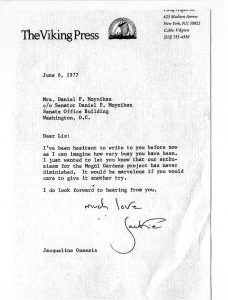I. An Unplanned Life: In Search of Mughal Gardens


By Elizabeth Moynihan
—E. M. Forster
Surveying the Surviving Mughal Gardens: The Beginning
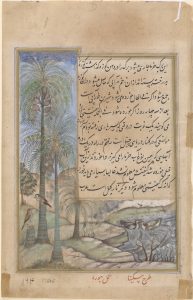
During the spring of 1965, I spent a wonderful month at the American Academy in Rome—an experience that enriched my life. This was my introduction to Italian gardens, and I left Rome with a craving to learn everything about them. To prepare, during the 1965–66 academic year I studied Italian at Wesleyan University, where my husband, Daniel Patrick Moynihan, was a fellow at the Center for Advanced Study. The following summer, he became the director of the Joint Center for Urban Studies at MIT and Harvard; we moved to Cambridge, and I continued to study Italian.
At the American Academy, I’d met Professor James Ackerman and was privileged to take his course in architectural history at Harvard, which led me to focus on the architecture of the great Italian gardens. I was also a member of the landscape architecture seminar at the Radcliffe Institute, where my primary interest became the history of gardens. Things were falling into place, and I planned to research the ornamental use of water in early palaces over the next few years.
Then, quite unexpectedly in November 1972, President Richard Nixon asked Pat to become the US ambassador to India. During the lead-up to the 1965 India-Pakistan War, Pat had served as the public member of the US delegation to the United Nations and had publicly disagreed with the “tilt” to Pakistan, as the position taken by the president and secretary of state was called. His appointment was seen as a gesture toward improving the relationship between the democracies. Pat accepted because he hoped to negotiate a solution to the rupee debt India was carrying for US food it had received under PL 480 (the Food for Peace initiative) after successive monsoon failures in India caused severe crop shortages in the 1960s.
I had never traveled to India. What I knew, I’d learned from my friend Lochi, the lovely Indian wife of our friend Nathan Glazer, a sociologist at Harvard. My children and I began reading and trading books in preparation for our move. We found a few recent books on Indian architecture with beautiful photographs and descriptions of forts and temples, but nothing on gardens other than a few references to the magnificent lakeside gardens in Kashmir.Then, just as we were packing for India, I heard from our friend Anne Freemantle about Gardens of the Great Mughals (1913) by Constance M. Villiers-Stuart. Anne lived in New York but had grown up in London and remembered “Mother’s friend Mrs. Stuart who called to give her the book and always reminisced about India.” It is a lovely book, illustrated with Mrs. Stuart’s charming watercolors, but it is also carefully researched, historically correct, and shares interesting comments and opinions. Our first Easter in India brought a package from Anne, her mother’s copy of Mrs. Stuart’s book, which I still treasure.Constance Mary Fielden was an intelligent woman and a good writer who married Lt. Col. Patrick Villiers-Stuart in London in 1908 and accompanied him to India. After considerable research and extended visits to the gardens, in 1913 she produced the first serious book in English on Mughal gardens. She sought expert advice from Indian scholars as well as British officials, including the director-general of archaeology of the Archaeological Survey of India, and she had access to the India Office Library. She became an acknowledged expert on Indian garden traditions, and in the course of doing so learned much about the complex culture. She frequently bemoaned the introduction of the bare English lawn to India and the “mistaken zeal for English landscape gardening in India.”Mrs. Stuart hurried to publish, as she explained, “owing to my desire to illustrate the bearing of Indian garden craft on the pressing problem of New Delhi.” She’d hoped to influence Edwin Lutyens’s design of the garden for the Viceroy’s House (now Rashtrapati Bhavan, the official home of the president of India). Reading her book sparked an idea for how I could continue my studies in India: I would attempt to survey the Mughal gardens she described, the ones that had survived. I discussed this with Diane McGuire, landscape architect at Harvard, who had set up the Radcliffe Institute seminar on landscape design. She responded enthusiastically to my suggestion, and I hoped she would come out and we could survey the remaining Mughal sites together. Sadly, Diane’s University responsibilities kept her in Cambridge, so we couldn’t collaborate on the survey.Before I read Mrs. Stuart’s book, I had never heard of Babur, the first Mughal emperor (reigned 1526–30), or his autobiography, the Baburnama (fig. 1). She quoted the book extensively with such admiration, I was anxious to read it.
Reading the Baburnama Changed My Life
The Baburnama was a very tough read. The names were unfamiliar, difficult, and inconsistent; occasionally Babur referred to the same person by two or three different names, and place-names and events were hard to follow. It required concentration. But I was immediately taken by his candor and frank assessment of the colorful, powerful personalities that dominated his complex, violent world, and struck by the contrast of that world to his observations and curiosity about the natural world.
How can I describe it other than to say I became absorbed by it? I was gripped by Babur’s adventures, amused by his rowdy escapades with his friends, plagued by the gaps in the narrative, charmed by his descriptions of the flora and fauna of India, impressed by his diplomatic skill and poetic gift, surprised by his self-awareness and understanding of the fragile nature of loyalty, moved by his kindness to his aging female dependents, thrilled by his military victories, and troubled by his increasing illness.
Today, there is a generation of scholars studying Mughal and Islamic gardens. More than forty years ago, when I first read Mrs. Stuart’s book and embarked on my own study, Mughal gardens were unfamiliar in general and not a subject of academic inquiry. Using the Baburnama as my initial guide, I acquired some knowledge and learned it did not matter that what had captured my imagination was arcane.
Mrs. Stuart and Babur became my constant companions and guides. I learned that E. M. Forster had also carried the Baburnama with him when he traveled in India, where he lived for a time as tutor to a Muslim prince in a small state. Forster complained about the names, the geography, and the gaps in the narrative, but he was charmed by Babur:
“He had all that one seeks in a friend. His energy and ambition were touched with sensitiveness; he could act, feel, observe, and remember; though not critical of his senses, he was aware of their workings, thus fulfilling the whole nature of man.”
—E. M. Forster, Abinger Harvest (New York: Harcourt Brace Jovanovich, 1971), p. 301.
There are three major gaps and many small blanks in Babur’s narrative, dating from the earliest known folios. Babur described a crisis he faced when he was caught in a rainstorm while dictating, then scrambled to retrieve windblown folios and spent the night drying them off. The book is fascinating in spite of the difficulty in reading it. As the first autobiography in Islamic literature, it is an important work, and it gives a rare and vivid account of historic events in a little-known area of the world at the beginning of the sixteenth century.
Babur wrote in Turki, a version that is now an archaic language, and his scribe made copies. It is thought that one copy went to each of Babur’s four sons; his cousin Haidar Mirza had a copy, and he sent one to his friend Khwaja Kalan in Kabul. The Baburnama was revered by all of the emperor’s descendants. Babur’s son and heir Humayun lost the throne and fled to Persia, but carried his copy of the Baburnama, which he annotated during his exile. Humayun collected books his entire life, and after his restoration, he built a library in Delhi, the Sher Mandal, where he fell and died in 1556 only one year after regaining power. His son Akbar succeeded to the Mughal throne and had his father’s copy of the Baburnama translated into Persian, which was completed in 1589. The fate of the other Turki copies is uncertain, though sections and fragments have turned up occasionally.
Translations of the Baburnama
Following Akbar’s example of having Babur’s memoirs translated into Persian, members of the imperial family and the court also had Persian copies made. Akbar had expanded the imperial atelier, and often these elegant volumes had exquisite miniatures illustrating scenes in Babur’s life, many set in gardens. The first English translation was based on a Persian text and published in Edinburgh in 1826; a French version was published in 1871. The Baburnama has since been translated into Uzbek, Russian, and, in 1995, Japanese by Prof. Eiji Mano, using collated Turkish text. Professor Mano has spent more than thirty years researching Timurid history and the Baburnama.
Annette Susannah Beveridge (1842–1929), née Akroyd, was a longtime resident of India; her husband, a British judge, shared her interest and talent for translating Indian manuscripts. She learned Persian when she was in her fifties and translated Gulbadan’s Humayun-nama, then learned Turki so she could translate an authentic Turki text of the Baburnama her husband had located in Hyderabad. It was published in two volumes (vol. 1 and vol. 2) in 1922. Mrs. Beveridge’s translator’s notes, appendices, and extensive index are invaluable in understanding the text.
She had arrived in India as Annette Susannah Akroyd in 1872 to establish a school for girls, and returned to England as Mrs. Henry Beveridge with her four children in the spring of 1890. As she worked on her translation of the Baburnama, published in 1922, Constance M. Villiers-Stuart was visiting Mughal gardens and learning about Indian garden craft. Mrs. Stuart returned to England and completed her book in Norfolk in 1913. It does not appear that these women ever met or knew of each other’s interest in Babur.
In 1996, the Smithsonian’s Freer Gallery of Art and the Arthur M. Sackler Gallery published The Baburnama: Memoirs of Babur, Prince and Emperor. This new translation was edited and annotated by Prof. Wheeler M. Thackston, who explains in the introduction: “Every effort has been made to preserve the flavor of the original but to couch it in modern English.” Mrs. Beveridge’s Baburnamawas my companion for many years, but Professor Thackston does make Babur’s text more accessible, so it is his translations you will see here.
Wondrous India
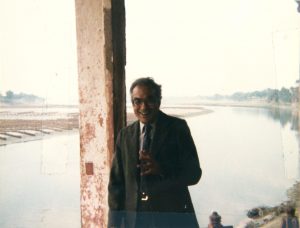
Once in India, our family focused on getting used to school, the routine, the embassy and the chancery, the household staff, the daily demonstrations against the “tilt,” the endless diplomatic events—all while feeling cut off from news and mail from home. Each Thursday, the arrival of Pan Am flight #1 was a big event; it brought the papers from the previous Sunday.
Trying to learn more about India, we consumed books, mainly history but also fiction— especially Ruth Prawer Jhabvala’s evocative stories of India in transition. Not long after our arrival in India, we met the Jhabvalas. At that time, Ruth’s husband, Cyrus Jhabvala (fig. 2), was the dean of the School of Planning and Architecture in Delhi and fondly known as Jhab by all his students. As a young architect and gifted artist, he spent many weekends with Ruth in the archaeological bungalow at Fatehpur Sikri; he would draw Akbar’s deserted city (fig. 3), and she would write her elegant, perceptive prose.

Meeting Jhab was a stroke of great fortune for me. He was an expert on Mughal architecture and not only encouraged my plan to survey the gardens but generously offered to teach me about Mughal architecture. My classes were visits to Mughal-era sites. Sometimes Jhab would accompany me, or he might send me off with an assignment. Once, during a visit to a Mughal tomb, he pointed out an architect’s instructions to the masons etched into the plinth, the equivalent of today’s blueprints. He also explained how the guilds functioned and still followed traditional methods.
In 1973, the Qutb Minar, the tallest brick minaret in the world, was still beyond the southern outskirts of Delhi, an area of abandoned tombs, crumbling walls, and scattered ruins. One morning we drove a few hundred yards beyond the Qutb to a mosque barely visible through dense scrub. It was a compound that had been completed in 1535, five years after Babur’s death. While not an exact precursor of the Mughal style, it was transitional in that it was a masonry structure of superior workmanship not seen in the prevailing examples built in the late Pathan style.
Concealed in the overgrown enclosure was a jewel: a small mosque of five bays with a single dome, no cloisters, and the tomb of a poet whom Babur admired. Shaykh Fazl-Ulla wrote under the name Jamali, to which he added Kamali, meaning the Wondrous One (fig. 4). During the political uncertainty of Babur’s first winter in India, the shaykh used his influence to gain public support for the emperor. They had a shared interest in poetry, and with other poets the shaykh attended a feast Babur held in Agra in December 1527. He also accompanied Babur on part of his eastward march in 1529.
The shaykh’s tomb is paved in marble, and the interior plaster is decorated by carvings in graceful floral designs into which red, blue, and gold were burnt with lac, a resinous substance like shellac widely used in India. Verses from Jamali’s poems are carved around the tomb, a small gem and a total surprise. The surrounding area is now fully developed, swallowed up by the expanding city but, happily, this site, universally known as Jamali-Kamali, has recently been cleaned and well restored.
It was a great experience to accompany Jhab on a walk in Old Delhi. Once, as I followed along through the maze of narrow, crowded lanes behind the Jama Masjid, he explained how most of the Mughal-era mansions were leveled by the British after the 1857 Sepoy Rebellion. Occasionally Jhab pointed out Mughal remnants—an arch filled in by crude metal doors, a crumbling stone wall or a piece of carved stone with so many layers of whitewash the design was obscured. He knew every nook and cranny, so in addition to an architectural tour, I had a history lesson enlivened by his biting humor.
Persian Gardens
As ambassador, Pat focused on the PL 480 rupee debt, and a negotiated settlement was signed in February 1974. Unfortunately, he was often ill and returned to his teaching position at Harvard in the spring semester of 1975. When he left India, the United States did not yet have full diplomatic relations with China, so it was unusual when the Chinese government invited him to stop in Beijing. Two of our children, Maura and John, accompanied him. I went to Iran.
In the first chapter of her book, Mrs. Stuart refers to the Song of Songs (also known as the Songs of Solomon) and links the influence of Persian poetry with its garden imagery directly to Mughal gardens. I had made one quick trip to Iran in 1973 but had not been able to visit Isfahan and Shiraz, and it was important to see the old Persian gardens. Stopping there on my return from India was an opportunity I couldn’t pass up. I saw some of the most important gardens and then went on to London.
In early 1975, it was still possible to study Mughal manuscripts at the Victoria & Albert Museum and the British Library without a gloved staffer turning the folios, and I spent ten days in London beginning each day with those treasures. I was also anxious to meet some British scholars who were experts on Mughal history. Mrs. Mildred Archer was very generous with her time and gave me access to material in the India Office Library, as did Nora Titley at the British Museum, and Robert Skelton at the V&A was extremely helpful. Betty Tyres at the V&A told me about the recently published book The Gardens of Mughal India by Sylvia Crowe, Sheila Haywood, Susan Jellicoe, and Gordon Patterson. I was thunderstruck—it was so similar to my research and followed the outline of what I planned to write for the Radcliffe Institute. This news put that project on hold.
The Road to Paradise
Pat taught the spring semester and then, with another leave from Harvard, went to the United Nations as the US permanent representative. It was a tempestuous time, and he only stayed seven months. Then we were back in Cambridge, but not for long. The most unusual change came next; in 1976, Pat ran for the US Senate, and we moved to Washington in January 1977.The move to Washington meant getting settled once again, and I regretted leaving the garden connections I’d established in Cambridge. It felt like a rescue when I was asked to be a member of the board of advisors at the Dumbarton Oaks Research Library and Collection, administered by Harvard University. Through Dumbarton Oaks, I was privileged to get to know Wilhelmina Jashemski, and a few years later to lecture in her seminar on ancient gardens. Prof. Elisabeth B. MacDougall, director of the Center for Studies in Landscape Architecture at the Oaks, was always encouraging and interested in Babur and his gardens.

In the fall of 1977, I heard from William Howard Adams, the general editor of the series World Landscape Art & Architecture published by George Braziller and the author of The French Garden. Howard asked me to write the volume tracing the development of the paradise garden in Persia and India. Having put my garden research aside, I accepted with trepidation and excitement. I had already done much of the research, but I was happy and relieved to learn that the Library of Congress had complete sets of the reports of the Indian Archeological Survey by Cunningham, Ferguson, and regional directors, as well as journals of the early travelers and gazetteers. I have always enjoyed doing all of my own research. However, I wanted to return to Iran once more and follow Babur’s route from Central Asia to India; I wanted to see what had influenced him.
My daughter Maura (fig. 5) took leave from Harvard for the spring semester of her sophomore year and joined me in Tehran. We visited Iranian gardens, then flew to Kabul; we went to Tashkent, Bukhara, and Samarkand but were not allowed to travel to Ferghana, a big disappointment. We returned to Kabul and followed Babur’s land route to Agra. I then went down to Dholpur and found his Lotus Garden. I returned home and wrote Paradise as a Garden in Persia and Mughal India, published by George Braziller in 1979.
In 1980, I became a board member of the American Schools of Oriental Research and served a term as chairman. I was on the visiting committee and then the board of the Freer and Sackler Galleries. I also served on the Indo-US Sub-Commission on Education and Culture until it was disbanded in 1996; many of the projects were with the Archeological Survey of India. When the sub-commission met in India, I would remain to do fieldwork on sites mentioned by Babur; I continued to travel with the Baburnama as a guide and was able to identify four other Baburi sites.
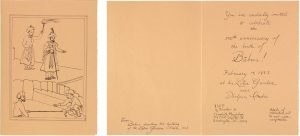
Mine has been an unplanned life, and I am grateful for so many interesting experiences. However, as a family, we were too much in motion; we moved fifteen times, and each of our three children changed school six times. We were lucky to have our farm in Delaware County, New York, to retreat to for almost forty years. Pat was a writer first, and his study was a one-room schoolhouse on the dirt road on the hillside above our house. It was where he wrote many books and his constituent newsletters. He loved it. When he entered the schoolhouse, the words flowed; that made his life possible.
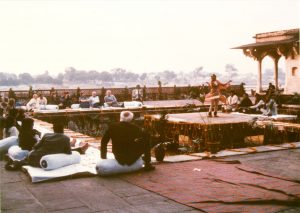
And a book made my life possible. The Baburnama changed my life. Actually, it was two books; the first was Mrs. Stuart’s Gardens of the Great Mughals, which introduced me to Babur and to the study of that landscape tradition. The most important lesson I learned was that being seized by an idea is one of life’s blessings. It does not matter whether other persons are interested; the reward is learning about the subject that grabs you. I also believe that without the personal sense of fulfillment I experienced from learning so much through these two books, I would not have been equal to the demands of my husband’s very public life. Pat knew and appreciated this.
On the occasion of Babur’s five hundredth birthday, I arranged a Mughal garden party at the Ram Bagh Garden in Agra (figs. 6, 7). Pat proposed the following toast: “To the other man in my wife’s life.” Everyone applauded and laughed with him. Then he went on: “If your wife is in love with another man, it’s all right if he’s been dead for five hundred years.”
While I was finishing the book on the Paradise Garden for the Braziller series, I occasionally had lunch in New York with Jacqueline Onassis. She was then working at Doubleday and suggested that I write about finding Babur’s Lotus Garden. She thought that was a great adventure. At the time, I found focusing on history more appealing than writing about my personal experiences. Jackie offered to be my editor and believed we could create interest in Babur (fig. 8). Now, after all these years, I think she was right. I admired her intelligence and humor and am sorry I missed the opportunity to work with her. However, I am grateful for her friendly counsel, and this is my attempt to tell the story of seeking Babur’s gardens, as she suggested.
